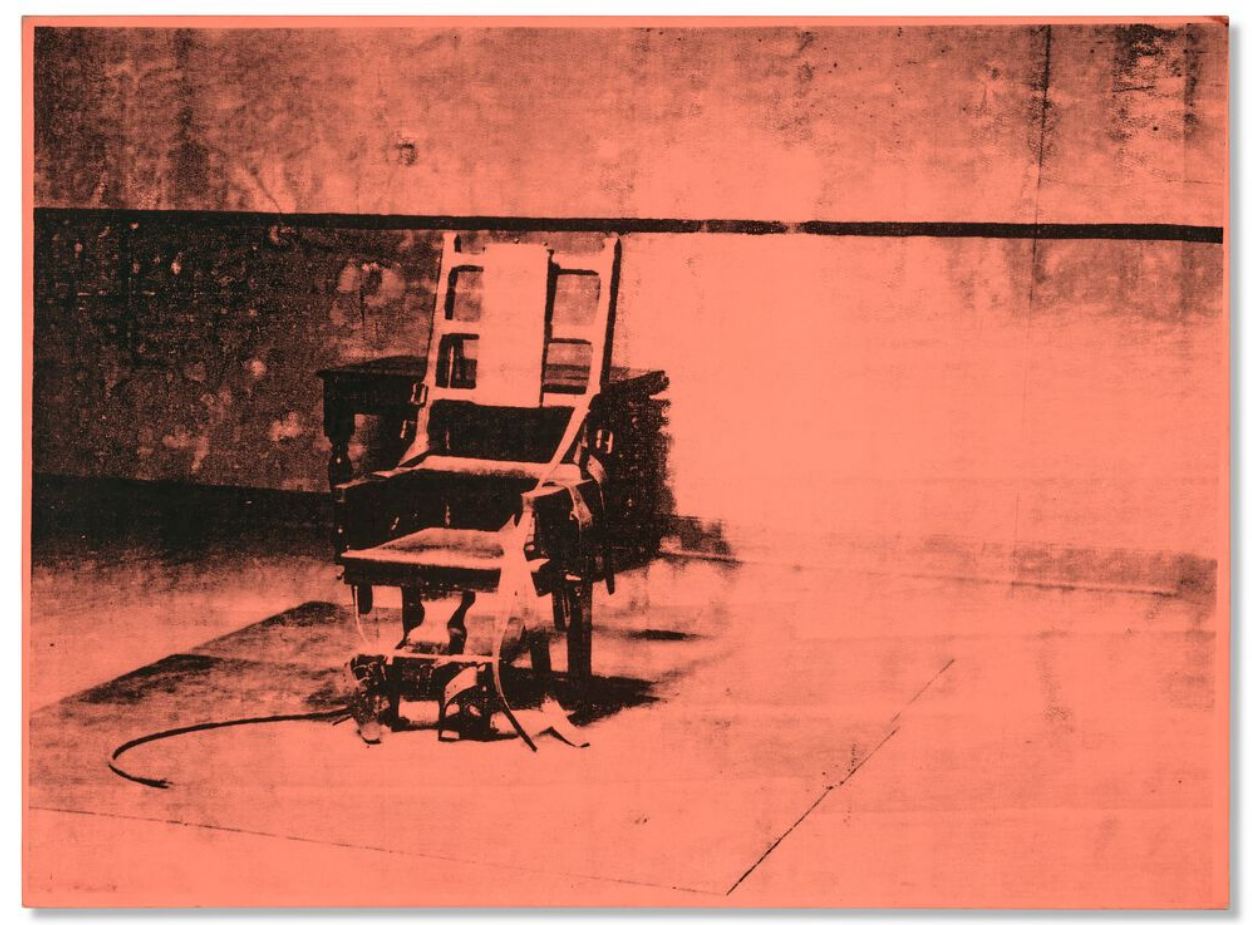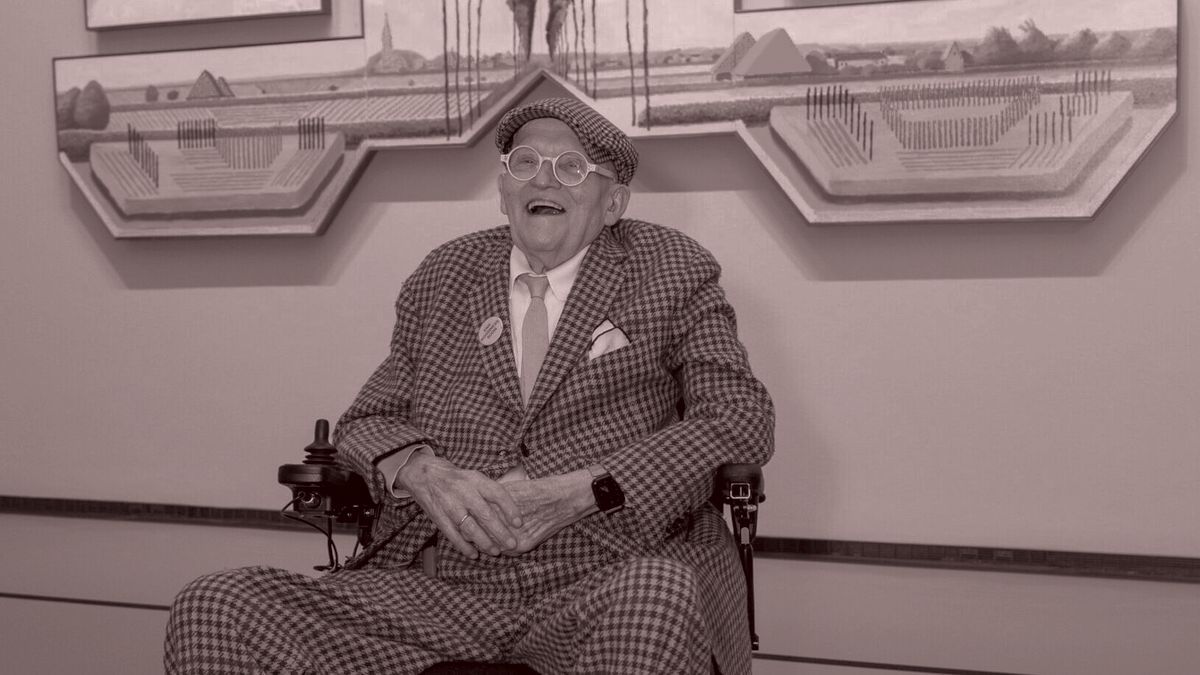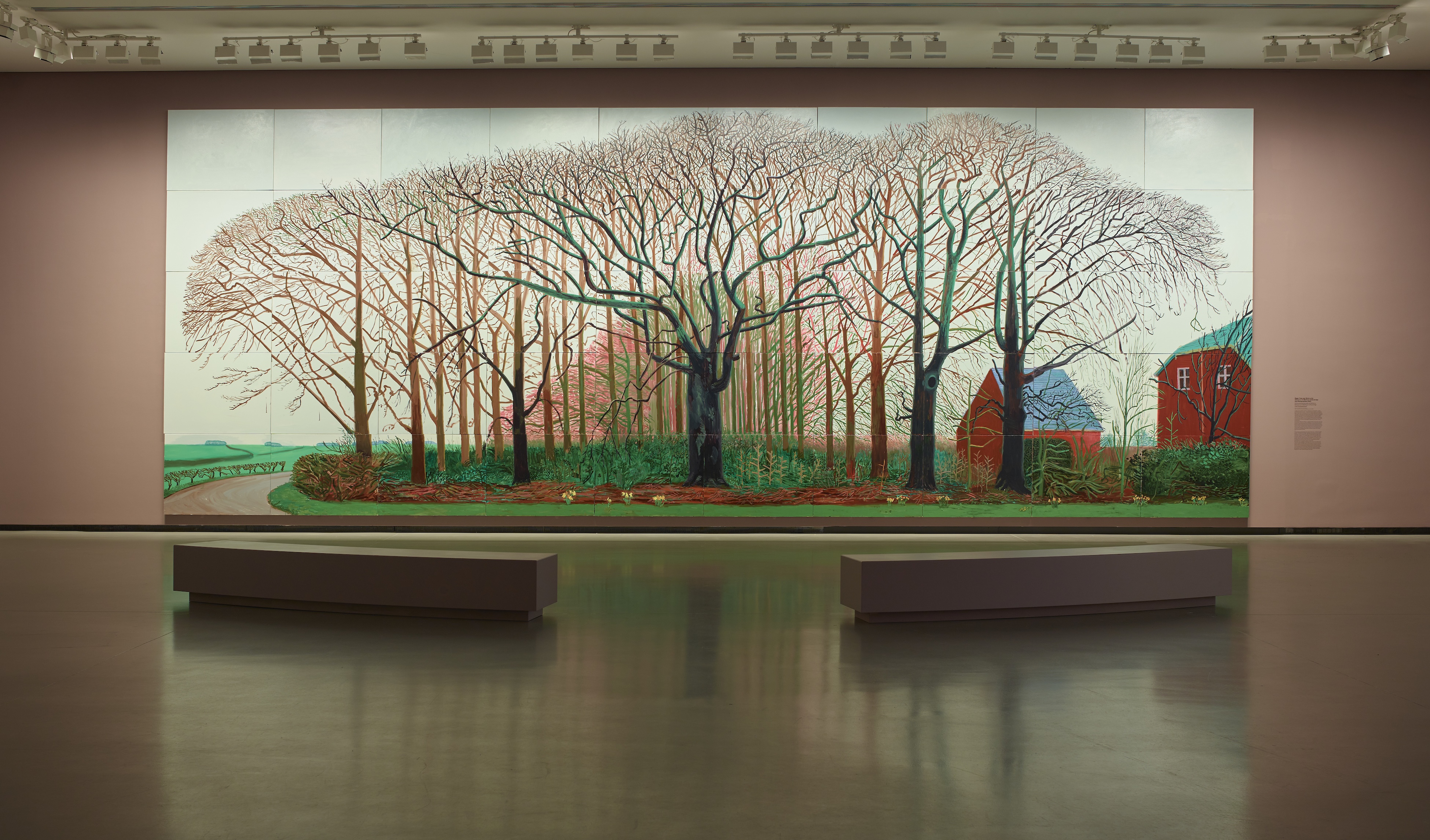Welcome back to Wall Power. I’m Marion Maneker.
Tonight, I’m
going to look at the huge new David Hockney show that just opened at the Fondation Louis Vuitton in Paris. I’ve yet to go, but reading through the catalog really makes me want to get on a plane for a quick break. I also devote a fair amount of space to today’s announcement that Christie’s will be selling a big dramatic Warhol painting. There’s no published estimate on Big Electric Chair, which comes directly from the family of Belgian collectors who
bought the work straight from a major museum show in the late 1960s. The specialist behind the sale has an interesting take on the painting, which I’ll share in detail below the fold.
But first…
|
- Boston MFA’s not-so-new face: Pierre Terjanian was just promoted to director of the Boston Museum of Fine Arts, less than a year after joining the museum as chief curator. Terjanian, who was previously at the Met, replaces longtime director Matthew Teitelbaum, who held that role for a decade. For those keeping score, the Frick passed over their deputy director to bring in a new leader from outside; MoMA reached down a couple of levels for
its new director; and now the Boston MFA has promoted from within, sort of.
- Sotheby’s sells scroll for $32 million: Sotheby’s held its Fine Classical Chinese Paintings sale yesterday in Hong Kong, where a rare, Yuan dynasty–era scroll by Rao
Jie became the focus of an extraordinary, 95-minute bidding war. The scroll had been estimated at HK$10 million, but some 200 bids drove the final price to HK$250 million, or $32 million—25 times the estimate.
|
|
|
A MESSAGE FROM OUR SPONSOR
|
|
|
- Daniella Luxembourg at Sotheby’s: Sotheby’s also revealed on Instagram that it will be selling 15 works from the collection of dealer Daniella Luxembourg in May’s contemporary evening auctions. The official announcement won’t come until early next week, but the Instagram post shows a Lucio Fontana La fine di Dio work, a Salvatore Scarpitta bandage painting, a Michelangelo Pistoletto mirror nude, as
well as works by Alberto Burri, Claes Oldenburg, and Alexander Calder. More details next week.
- I want to hear from you now more than ever: The announcement that Christie’s will auction 15 artworks in May from Venezuelan collector Tiqui Atencio—who is moving from London to Monaco because of the Starmer government’s changes to the 15-year exemption on paying U.K. tax on overseas
earnings for non-domiciled residents—provoked one non-dom collector who lives in London to bemoan (via WhatsApp) about Britain’s new attitude toward the global, mobile rich. “The Brits have shot themselves in the foot,” the collector wrote, adding that she personally knew of 10 families leaving London. “It’s an impressive exodus.”
I’ve also been talking to different people in the industry about their view of the market as we navigate these unprecedented macroeconomic times. If you have
anything you want to share, please get in touch. I can be reached at 917.825.1391 on SMS, WhatsApp, and Signal. Or you can just reply to this email. All conversations remain anonymous, and you’re free to declare your opinions off the record.
It really does help to hear what you’re thinking. Is this a buying opportunity? Are you keeping your money in a mattress? With U.S. assets suddenly so risky, are collectibles and art a safe haven—or a last indulgence before the whole world comes to an
end? Let me know what you think.
|
Andy
Warhol, Big Electric Chair
Expected to Sell Above $30 Million at Christie’s in May
|
Andy Warhol, Big Electric Chair (1967–68). Photo: Courtesy of
Christie’s
|
Several years ago, I asked a contemporary art specialist at one of the auction houses
how to distinguish quality and value among the various examples of Andy Warhol’s famous electric chair image. The specialist replied that you really wanted to be able to “see the silence.” The image, depicting an empty prison execution chamber, is fraught with the consequence of its purpose, which makes the specialist’s words that much more profound. Or so I thought… until I looked more closely at the painting. Warhol’s silk-screened paintings are notorious for the variability
of their registration; some are crisp and precise, others are muddy and illegible. In this example of the image, I noticed a sign above the doorway to the execution chamber that read, “Silence.” The silence wasn’t a metaphor.
Today, Christie’s announced that it would be selling a Warhol electric chair painting that Alex Rotter, chairman of the 20/21 departments, has been chasing for years. Acquired by the Belgian collectors Roger Matthys and Hilda
Colle the year after it was first shown, in the 1968 retrospective of Warhol’s work held at the Moderna Museet in Stockholm, Big Electric Chair is expected to fetch $30 million or more during the May 20th century evening sale. The fact that it’s only ever had one owner is something that collectors at this level really prize.
The Big Electric Chair is more than 6 feet wide—not quite as big as the 82-inch square Flowers that Rotter sold for nearly $35.5
million last May. That sale was a record for a large Flowers painting, and it sent a signal that the Warhol market might be beginning to reprice. His work has reached spectacular nine-figure prices privately and at auction, but the large Flowers painting was one of the few Warhols sold in recent years to make a price in the $30 million range.
|
|
|
A MESSAGE FROM OUR SPONSOR
|
|
|
Only three Big Electric Chair paintings have sold at auction in the past 30
years, and all of variable quality. The first one made $2.6 million in 1999, when that was still serious money. Three years later, a lavender Big Electric Chair was auctioned at Christie’s for just under $5 million. There was a 17-year gap until the next Big Electric Chair was sold at auction, this time a jarring three-color version that made $19 million—an eight-fold increase in price over 20 years. That’s impressive, but it’s nothing compared to the 14-fold price
increase that the Orange Marilyn saw from 1998, when Si Newhouse paid the then-unimaginable sum of $17 million, to when Ken Griffin reportedly paid $240 million for it in 2017.
Although Warhol was known for making series of particular images, as Rotter points out, the electric chair was one of the few that he returned to over time, coming back later and subtly cropping out the door and the “Silence” sign. (He also made repeated self-portraits,
and he came back to Marilyn’s image in the reversals.) For Rotter, the electric chairs are more than just the defining image of the seminal Death and Disaster series. He’s convinced that this is Warhol’s contribution to the still-life tradition: the attempt to capture the evanescence of life and time, in a lineage that stretches from the Dutch masters to Cézanne. Instead of flowers that wilt and food that rots, Warhol is capturing the placid moment of
calm before the terror of execution. It’s very wry—and Warholian, as Rotter would say—to show us this instrument of capital punishment bathed in an upbeat salmon tone.
Of course, the painting is also Warhol’s nod to that other tradition the Old Masters relied on: the memento mori, or reminder of death. Sometimes it’s accompanied by the Latin motto, Et in Arcadia ego, which can translate as I, too, am in Arcadia—meaning that even in moments of sublime pleasure,
the certitude of death remains. Instead of a skull, Warhol offers the deracinated electric chair. Not everyone will accept Rotter’s interpretation. But, for me, it was another way to say that Warhol really does make you see the silence.
|
|
|
At 87 years old, David Hockney has the popularity and longevity to have
earned another retrospective, this one at the Fondation Louis Vuitton. His market is finally catching up to his wide appeal, with volume and valuations that beg comparisons with even Picasso.
|
|
|
It’s not uncommon to see an important artist with a long career get a major museum
retrospective near the end of his or her life. That happened eight years ago for David Hockney, who was 80 years old when Tate Britain organized a comprehensive look at his immense and varied output. The show then traveled to the Metropolitan Museum of Art in New York, where it had a breathtaking effect on the artist’s market. But it is rare to see that same artist receive another, larger museum show only a few years later.
That’s what is happening this week as David
Hockney 25 opens at the Fondation Louis Vuitton in Paris. The show quickly and dutifully recapitulates the artist’s early years and his early triumphs: the renowned double portraits and swimming pool pictures, including the famous A Bigger Splash, from 1967, and the now even-more-famous Portrait of an Artist (Pool with Two Figures), from 1972. Some of the big Los Angeles landscapes round out the brief introductory section before the show moves on to its focus: the
past 25 years of work from Hockney, a particularly facile and restless artist who, as the exhibition’s curator, Norman Rosenthal, reminds us, is not unlike Pablo Picasso in his constant search for new forms and styles.
There’s another Picasso comparison to make, too. The 2017 retrospective transformed Hockney from a beloved but not exceptionally valuable artist into one of the driving forces of the current art market. Prior to 2018, no
more than $38 million of Hockney’s art had sold in a single year, and that number was achieved only in the two years leading up to the retrospective. In 2018, however, Hockney’s market exploded to annual sales of $200 million, led by the $90 million paid by Taiwanese collector Pierre Chen for Portrait of an Artist (Pool with Two Figures), which was previously owned by the British collector and former Christie’s owner Joe Lewis.
|
|
|
Sales dipped to around $125 million each year for the next two years before peaking
again in 2022 at $182 million. Volume was down by half in 2023 but back up to nearly $150 million in 2024. Until 2021, there were never more than 60 lots by Hockney that came to auction. That number ballooned to 547 lots in 2023 before settling down to 349 last year.
To be sure, Hockney is no Picasso… at least not yet. Even a diminished Picasso market in 2024 was still doing $208 million in auction sales. And Picasso has many more different bodies of work that have recognized masterpieces
among them, whereas much of that has yet to happen with Hockney—and may not happen at all. But Hockney’s work is rising in popularity, visibility, and consequence on the auction market.
|
Unlike the Tate show from 2017, the Louis Vuitton show isn’t a retrospective of
Hockney’s entire career. It’s a personal journey through the past 25 years of the artist’s production, when he was living in Yorkshire, Los Angeles, Normandy, and London. For the casual viewer, it’s a reminder of the many different bodies of work in Hockney’s oeuvre. For the market, it serves a key function in educating potential buyers—even advisors—so that differentiations and distinctions can emerge. The art market, after all, is a distribution market, and it thrives on knowledge, exposure,
and discrimination.
The Paris retrospective may focus on his most mature years, but Hockney is also very aware that these years are a product of his continuing obsessions. “Not many artists have been drawing similar themes and the same people for more than 60 years,” he writes in the introduction to the show’s catalog. “What I am trying to do is bring people closer to something, because art is about sharing. You wouldn’t be an artist if you didn’t want to share an experience, a
thought.”
|
David Hockney, installation view of Bigger Trees near Warter or/ou Peinture sur le
Motif pour le Nouvel Age Post-Photographique (2007), Fondation Louis Vuitton, Paris. Photo: Courtesy of Fondation Louis Vuitton
|
The proper portion of the show begins with watercolors of the Yorkshire landscape before
mutating into vivid oil paintings in bright, saturated colors. After 2004, when Hockney returned to Yorkshire, the paintings became exceptionally big as he experimented with using panels: There’s a 15-by-20-foot painting of trees in Normandy, then some smaller works that are merely 9 by 12 feet. Charcoal drawings of the woods follow, then portraits and self-portraits, and even self-portraits with paintings of flowers, which lead to paintings of the flowers themselves (made on an
iPad).
After that come some fascinating paintings of people on rows of chairs, sometimes in front of mirrors or in front of Hockney’s paintings. Then we’re back to the iPad and paintings of gardens in Normandy, which segue into paintings of Normandy gardens in acrylic. Finally, as if tidying up stray themes, the show proceeds with Hockney’s various experiments with different media and perspectives, and a closing section of Hockney’s paintings of the opera.
It’s a lot of art—in a
lot of different forms. Poring over the catalog, I was struck by how many of the pieces were unfamiliar to me. Some of it is even off-putting, but in the way that means I’m seeing something I don’t quite yet understand. It all made me want to get on a plane for a weekend in Paris—and given how awful this past week has been, could you blame me?
But there’s another reason to pay attention to this vast cornucopia of Hockney’s work. While he has always been a popular artist, his market
popularity has never been greater than it is now. Invoking Picasso is one way to say that whatever you think you know about Hockney’s art, you’re probably missing something. In fact, you’re probably missing a lot.
|
It’s officially the weekend, folks. Enjoy yourself—and I’ll speak to you again on
Sunday.
M
|
|
|
The ultimate fashion industry bible, offering incisive reportage on all aspects of the business and its biggest
players. Anchored by preeminent fashion journalist Lauren Sherman, Line Sheet also features veteran reporter Rachel Strugatz, who delivers unparalleled intel on what’s happening in the beauty industry, and Sarah Shapiro, a longtime retail strategist who writes about e-commerce, brick-and-mortar, D.T.C., and more.
|
|
|
Need help? Review our FAQ page or contact us for assistance. For brand partnerships, email ads@puck.news.
You received this email because you signed up to receive emails from Puck, or as part of your Puck account associated with . To stop receiving this newsletter and/or manage all your email preferences, click here.
|
Puck is published by Heat Media LLC. 107 Greenwich St, New York, NY 10006
|
|
|
|













